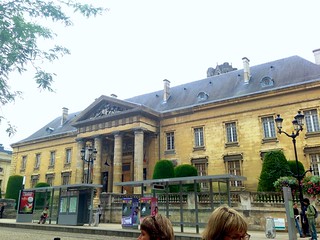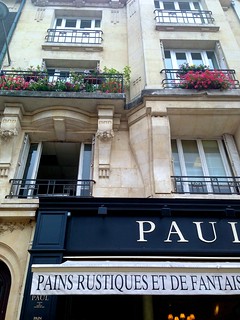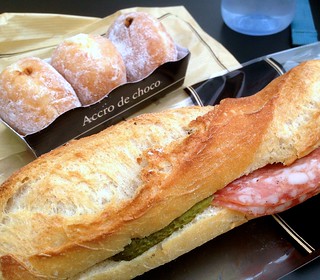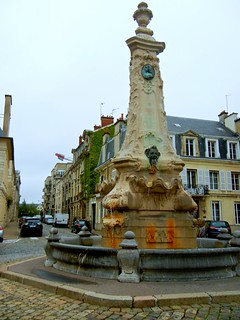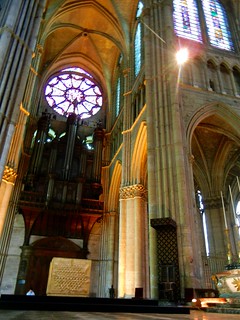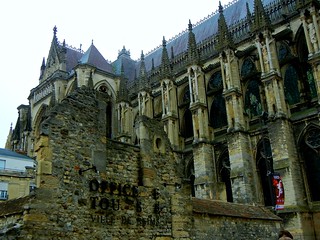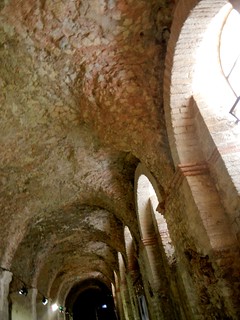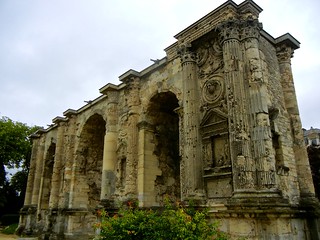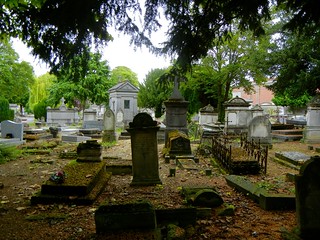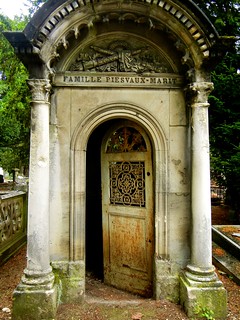While my parents were staying at my apartment over the past spring break, I woke up one morning to see a picture my dad had uploaded to Facebook of the view from my balcony. It looked almost alien -- beautiful, yes, with its mix of mountain ranges and sea of palm trees, but certainly not what I'd woken up to every morning for the past two years. When I asked him about it, he shrugged and said he'd cropped the rest out -- that is, the ugliness of my neighborhood that separated my apartment from the paradise of northern mountains.
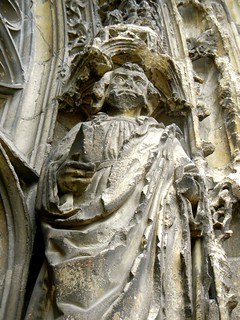
Sounds legit. I'll admit that I crop a fair amount in my own photos.
I could have gotten a better view from my apartment -- there were plenty of studio lofts that faced the pool far below, with its lovely greenery, hot tub, grills, and lounges. But to have a room with a view would cost me an extra $100 per month, which would easily translate to one triple-shot caramel latte every Saturday morning, brunch with a mimosa every Sunday afternoon, and at least four dresses at Ross.
Priorities, y'all.
Rooms with a view come at a price, which is simply something I've come to expect. And after living in Reims for almost a week, I can say that the entire town resembles something of a "village with a view".
Note: I say "village" to appease the government of France; Reims is still just as sprawling as the drive from Phoenix to Disneyland, but without the windmills. I type this while giving my feet a rest after a 30-minute walk to our conference center, which on the map seemed quite close.
 It shouldn't come as a surprise when I say that Reims is a historic town; all of Europe is a network of historic towns. But in this case, I'm not talking medieval times -- I'm talking 80 BC. Reims was actually founded by the Romans 30 years before Julius Caesar's conquest of Gaul. Its previous inhabitants formed the tribe of Remi, hence its name.
It shouldn't come as a surprise when I say that Reims is a historic town; all of Europe is a network of historic towns. But in this case, I'm not talking medieval times -- I'm talking 80 BC. Reims was actually founded by the Romans 30 years before Julius Caesar's conquest of Gaul. Its previous inhabitants formed the tribe of Remi, hence its name.
Having spent time in Jerusalem, Bethlehem, Nazareth, and surrounding areas, 80 BC shouldn't sound quite as impressive as it does; but the Holy Land, or at least what we see of it today, is quite new. After decades, centuries, millennia of raids, conquests, fires, and destruction, each city is built on the shadow of the last, so that a staircase stretching 50 feet underground is one of the only ways to see a snippet of the ancient Roman viae linking parts of the city with the central trading routes around it.
France has done a pretty good job of steering clear of warfare. I'll add a mental asterisk to that statement, because Reims was a central point of attack during both World Wars, but even so -- the ability to walk three minutes from the town's train station and stand before an 1,800-year-old, 40-foot-high Roman gate into the ancient city just blows my mind.
And what's more, it's no big deal.
I repeat: Reims is a room -- a mansion -- with a view.
So on that very first day, I walked only a few blocks north of Guillaume's apartment to visit the Basilique St. Remi, one of the most important Romanesque abbeys in France. It was built in 1050 to house relics of Saint Remi, who baptized Clovis (i.e., first king of the Franks) in 498.
After a slightly longer trek into the southernmost tip of the city's centre, I came to the Carnegie Library (Bibliothèque Carnegie), donated to the city after its substantial destruction in WWI. It is in this area that Reims feels like the stereotypical network of perfect French streets, narrow alleys of cobblestones and window baskets overflowing with flowers, small courtyards with chirping birds, and the smell of freshly baked bread around ever corner.
By this point, I was famished -- and I followed my nose to a patisserie in a small square surrounded by the Palais du Justice and Opéra house. The 125-year-old patisserie, simply called Paul, not only boasted a window full of baguette sandwiches, pastries, and salads, but also prices fit for any grad student.
France, in case anyone was wondering, makes Disneyland prices seem reasonable.
Armed with a salami-pickle baguette, Evian, and three chocolate-stuffed beignets, I found a table in the square outside and sat, like a little French woman, to enjoy my food and my surroundings. My table afforded a great view of the open windows directly above the patisserie, where the chefs -- both men and women -- rolled and baked bread while chatting happily and waving to customers in the street below.
The Palais du Tau, which sat directly across the street, was the former palace of the archbishops from medieval times. It has since been turned into a museum, and is where the conference will be hosting a welcome reception (and drinks...let's not forget the free drinks) this evening.
And only a few blocks away stood the magnificent, regal Notre-Dame de Reims, which functioned as my landmark (much as A-Mountain functions while in Tempe) as I made my way around the city centre. It loomed up from above the rooftops, casting many of the houses and shops below in shadow even at noon.
Before I discuss Notre-Dame, I wanted to make a side note about public toilettes in Reims and, as I hear, in Paris as well.
Toilets should not be hard to come by.
Walmart has toilets.
Target has toilets.
Grocery stores have toilets.
But the French treat toilets like the most obscure pair of gardening gloves that only one out of ten Home Depots actually holds.
When I first arrived at the Paris airport, I was parched. Arizona girls equate "parched" with "early death", and regardless of the 94% humidity, I was determined to find a water fountain.
But after butchering my way through a few sentences in French, I was told that the airport didn't have water fountains.
Not gardening gloves -- for all I know, and with the number of Guccis, Pradas, and Louis Vuittons in that airport, they might have had some designer gardening gloves sitting on a shelf for 4.500€. No, they didn't have water fountains.
At the look on my face, the woman behind the information desk held a finger to her lips, ducked beneath the desk, and reemerged with a bottle of cold water. Bless her soul.
But the story has remained the same in the days since: France just doesn't drink a lot of water. Even their coffees are 4 ounces, tops.
And now we know why: No one can afford to experience a full bladder when outside their own homes.
So let's talk a bit about my experience with public toilettes.
After practically dancing from Paul to the tourism office outside Notre-Dame, three women each pointed me in different directions to find a public restroom. I danced my way around the block, into a few museums, into (what I later found out was) a government building from which I was promptly shooed out, and finally -- in a state of desperation -- I happened to see a small blue sign on the side of a stone wall that read Toilettes / WC.
Thank God almighty.
I rushed down the stairs into a small basement space, and almost ran headlong into a desk at the entrance. A woman, who was flipping casually through what seemed to be the French version of People, looked up, popped her bubble gum in my direction, and watched me...because I'd frozen in my steps.
In uncertain situations, I get really socially awkward. I mean, like, painfully socially awkward.
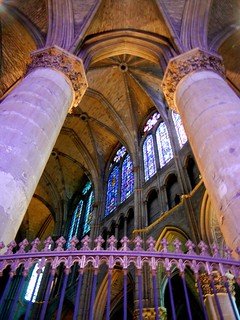 And when I saw the small container of Euros sitting in front of this bubble-popping, magazine-reading Guardian of the Toilet, my first reaction was incredulity. Certainly -- certainly -- it didn't cost money to use the bathroom when there were none else available in the town.
And when I saw the small container of Euros sitting in front of this bubble-popping, magazine-reading Guardian of the Toilet, my first reaction was incredulity. Certainly -- certainly -- it didn't cost money to use the bathroom when there were none else available in the town.
But then, people don't sit at bathroom desks reading magazines with Euro-filled containers just lying around.
So I pointed at the container, mouth hanging slightly open in a question I didn't know how to articulate in French, and then looked back up at the Guardian. She was still staring. I pointed vaguely at her, mouth still open, then pointed back to the container. My gaze -- and my finger -- drifted to the bathroom stalls to the left, then back to the container.
And, still facing the Guardian, finger still extended, I side-stepped like a crab into the nearest bathroom stall and locked the door.
Even now, days later, my super-ego is shaking its head in shame. When I rushed out the door several minutes later, the Guardian was shaking her head, as well -- although I imagine for a different reason.
Immediately outside was the tourism office directly responsible for Notre Dame-specific information. It is, after all, a major Catholic destination and sees more than one million visitors each year. It was built on the site of Roman baths in the third and fourth centuries, and has since flourished into a massive 1,000-year-old cathedral. It is currently one of the top 10 largest, and longest, holy sites in the world.
But its tourism office was a disappointment. It sat, crumbling and ruined, missing half the iron letters in its title, in the center of what was otherwise a beautiful plaza. My first thought was one of tackiness at trying to achieve a symbol of history, when its towering neighbor didn't even have to try.
Oh, how little I knew.
 The tourism office was one of tens of thousands of sites destroyed by German bombing in WWI. I mentioned in a previous post that Reims boasts close proximity to Germany, hence a wide variety of German foods; well, in times of war, there are downsides to this proximity. Other than to replace the roof, it has since remained untouched and yet fully functional.
The tourism office was one of tens of thousands of sites destroyed by German bombing in WWI. I mentioned in a previous post that Reims boasts close proximity to Germany, hence a wide variety of German foods; well, in times of war, there are downsides to this proximity. Other than to replace the roof, it has since remained untouched and yet fully functional.
The inside of the Notre Dame is simply incredible, and I've seen a fair share of cathedrals and basilicas. On the inside, they've set up a series of historical images and descriptions (thankfully translated in English and German) describing the cathedral's near destruction during World Wars I and II. From 1914 to 1917, for example, Reims was almost constantly under attack. In just 10 days in April of 1917, more than 37,000 shells fell on Reims -- which caused such terror that the mayor moved the town hall to the cellars of a nearby winery. (A priceless picture showed a table full of men, surrounded by bottles of champagne.)
 Out of 13,806 houses in Reims, by the end of WWI only 17 homes were left undamaged; and decades later, the post-WWII French-German reconciliation occurred right in the heart of the cathedral.
Out of 13,806 houses in Reims, by the end of WWI only 17 homes were left undamaged; and decades later, the post-WWII French-German reconciliation occurred right in the heart of the cathedral.
Truthfully, an incredible place.
I made my way to the Plaza du Forum in north Reims, which -- unlike all other plazas I'd yet seen -- was sunk into the ground. A large stage for summer concerts was erected at the bottom of the plaza, farthest from the surrounding streets, and along the back stone wall were several arched wooden doors.
No one would have known that those doors hid an 1,800-year-old Gallo-Roman crypt, the cryptoportique. (It's unclear whether it was originally meant for grain or bodies because, you know, the two are pretty similar.) The inside was a little underwhelming -- local student artists had set up a series of galleries relating food to four-dimensional touch, and it might just be me, but I'm a little more interested in ancient crypts than I am in a dish of pasta made out of aluminum foil.
Even so, the element that struck me most was the smell that hit me in the face as I walked into the crypt. If my eyes had been closed, I might have sworn that I was back in some of the underground crypts in Nazareth or Jerusalem -- the smell of ancient history (read: dust, rock, and stale air, which just doesn't sound as romantic) was discernible immediately.
My last stops comprised la Porte de Mars, a gate built in the early 200s AD that led directly into the Gallo-Roman city, followed by an expansive and incredibly old and beautiful cemetery (circa the early 1700s), and Foujita Chapel, an Anglican chapel from the mid-1960s known for its wall-to-wall frescoes.
And then, thoroughly exhausted and aching from my walk, I took a tram to Comèdie in west Reims to check into summer school. For those who didn't know, I've just finished a four-day intensive summer school program through the International Association for Cross-Cultural Psychology, which brought together 43 students from 21 countries around the world. It was an intense few days, stretching between 12 and 14 hours each day and relying almost exclusively on interdisciplinary group work, but the experience was unbeatable.
I will explain a little more in the near future (nothing crazy, just a paragraph or so), but for now, I will say that the first thing I did upon arriving at the hostel was to set down my bags, climb into bed, and fall into a deep, jet-lagged sleep.
